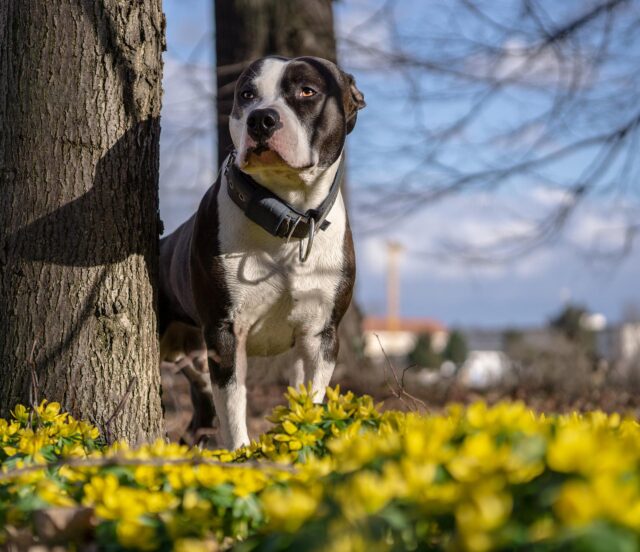A curious Staffordshire Bull Terrier died tragically because there was no cure for her wound. She had a blister that kept getting bigger and bigger until she had to be put down. The only thing that led to this heartbreaking fate was touching a plant at a park.
Now, the deceased dog’s human is warning others to beware of the plant known as “Britain’s Most Dangerous Plant.” While it’s rare to come across this invasive weed, all it takes is one touch for a life to be ruined. So, be cautious next time you walk your dog at a public park.

Curious Dog Experiences Unexpected Pain
When the tragedy began, Stuart Good was walking with his dog, Ella, and his friend, Clive Ransom. They explored the Port Sunlight River Park in Birkenhead, England. Ella went into the weeds to explore for a few moments, but then she let out a sudden yelp and ran as if something scared her.
No one thought anything of it at the time. The trio kept walking, and then they all went home. But shortly after, Good called Ransom and mentioned that Ella had a large blister under her front leg that he’d never seen before.
“She came out of the bushes yelping, we didn’t know what it was and she had a little blister about the size of a £1 coin under her front leg and that then developed,” Ransom explained. “The next day it was double the size and the next day it was double the size again. I said ‘right that’s it’ because Stuart doesn’t drive I took him to the vets.”

The vet said that the wound was caused by giant hogweed, which doesn’t have a cure. They prescribed painkillers, but all Good could do was give Ella some great final days and then say goodbye when she could no longer maintain a good quality of life.
Look out for Giant Hogweeds
Ella’s blister continued to grow until it took up half her side and became an open wound. At that point, Good made the heartbreaking decision to put the 13-year-old dog down.
“Stuart had to throw his bedding away. He loved the dog so much he had her in bed with him to keep her comfortable. It was devastating for him,” Ransom said.

RELATED: Toxic Algae Unexpectedly Kills Several Dogs Playing Near Water
The Land Trust, which owns Port Sunlight River Park, is aware of this issue. They said they haven’t seen any giant hogweed in the park, but their rangers will continue to conduct health and safety checks. They also pointed out that there is common hogweed in their parks, which looks similar but isn’t threatening to humans or animals.
Good is warning other dog parents to keep an eye out for these life-threatening plants. Keeping your dog leashed on walks is a great way to prevent this incident from happening. Nothing will bring Ella back, but hopefully, the pup’s story will prevent more dogs from meeting this tragic fate.
How to Identify Giant Hogweed
In photos, giant hogweed looks similar to other weeds, but in person, it’s hard to miss it. It’s massive, so it lives up to its name. Here are some characteristics to help you identify it:
- Grows 7 to 18 feet tall
- Leaves can grow to five feet across
- Leaves have ridged edges
- White flowers appear in late June and July
- Flower clusters contain 50 to 150 flowers and grow up to 2.5 feet across
- Stems are covered in white bristles and small red markings
If you suspect that a plant is giant hogweed, keep your distance from it. If any humans or pets come into contact with a plant that has these characteristics, seek medical attention right away.

Where Does it Grow?
Giant hogweed is native to central and southwest Asia, but it’s an invasive species that has been introduced to many other areas. It can now be found in parts of Europe and the United States.
You can report giant hogweed if you see it, but where to report it depends on where you live. Environmental departments and public parks will likely remove the plant if alerted of it. Then, no one else will have to suffer the way Ella and her family did.
 Toledo, United States.
Toledo, United States.